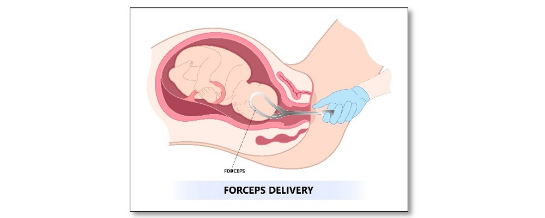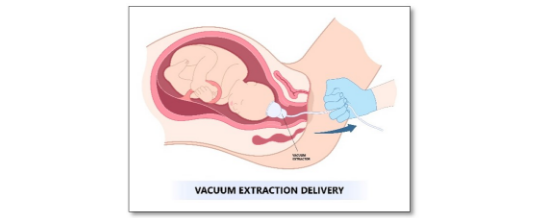Assisted Vaginal Birth (Forceps or Ventouse)
This leaflet will give you useful and important information about assisted vaginal birth and will answer all the questions in your mind while you are pregnant to help with planning your birth.
An assisted vaginal birth (instrumental birth) is when an Obstetrician needs to use forceps or ventouse suction cup to assist you to deliver the baby.
About 1 – 15% of women have assisted vaginal births worldwide.
Forceps
Forceps are smooth curved metal instruments that look like large spoons. They are made to carefully fit around a baby’s head. When you are pushing with the contractions, your doctor will gently pull to deliver the baby. The delivery may happen over more than 1 contraction.

Ventouse
Ventouse or vacuum cup is an instrument which uses suction to attach a plastic cup to the baby’s head. When you are pushing with the contractions, your doctor will gently pull to deliver the baby. The delivery may happen over more than 1 contraction. Sometimes, the cup may detach making a ‘pop’ sound. If it happens, doctor might need to reapply the cup.

Why I might need help with birth of my baby?
The main reasons are:
- There are concerns about your baby’s heart rate
- Your labor is not progressing as expected
- Your health care team advised that you do not push due to underlying medical condition like high blood pressure
Can I reduce my chance of needing an assisted birth?
You are less likely to need an assisted birth if
- You are well supported in labor by someone you know like partner, family member or friend
- You do not have any complications in pregnancy
- You are using upright position or lying on your side after your cervix is fully open in labor
- You do not start pushing as soon as your cervix is fully open and allow time for baby’s head to go down the birth canal for about 1-2 hours or till you feel an urge to push
Epidural (an injection for pain relief) may slightly increase your chance of needing an assisted delivery by prolonging the duration between when your cervix is fully open and birth of your baby.
Do I have a choice between forceps and ventouse?
Forceps and ventouse (vacuum, kiwi cup) are both safe and effective.
The choice of the instrument will depend on factors including:
- Your baby’s well-being
- The urgency for delivery
- Whether you have an epidural
- Whether you are preterm or term (forceps is the preferred instrument if less than 36 weeks as it is less likely to cause injury to baby’s head which is softer at this stage of pregnancy)
Your doctor will choose the instrument which is most appropriate for your individual situation. If you have concerns regarding the use of forceps, ventouse or both, you should discuss with your doctor during the pregnancy or in labor.
If one instrument is not effective, your doctor may then recommend to use other instrument to help you have a vaginal birth or offer Cesarean section depending on your individual circumstances.
What are my alternatives to assisted vaginal birth?
- Forceps or ventouse will only be recommended if they are thought to be the safest way to help you give birth. If you are in labor and choose not to have an assisted birth, the alternatives are to wait for natural birth or have an emergency cesarean section. Your doctor will discuss the options based on your individual circumstances.
- A cesarean in late stage of labor may increase the risk of harm to you and your baby.
- Decision making in labor can be difficult and it is important to discuss your concerns before you go into labor.
- If you are certain you would not want an assisted vaginal birth, one option is to choose a planned cesarean section.
What happens during an assisted vaginal birth?
- Your doctor may recommend the assisted birth in either the delivery room or in the operating room depending on the difficulty of your situation.
- If your health care team think that there is a chance that it might not work, you will be advised to give birth in the operating room.
- Your doctor will examine your abdomen and perform an internal examination with your consent to confirm that an assisted birth is safe for you and your baby.
- Your bladder will be emptied by passing a small tube(catheter) if you do not already have one.
- If you do not have an epidural, a local anesthetic injection will be given inside the vagina and/or in the perineum.
- You are more likely to need a cut(episiotomy) with an assisted birth.
- An antibiotic will be given through drip just before or after the assisted birth.
- A health care professional who specializes in the care of newborn babies will be present in case your baby needs extra support after birth.
- If your baby is well, you may choose to have immediate skin to skin contact and delayed cord clamping.
Am I at risk if I have assisted vaginal birth?
- Both forceps and ventouse assisted births are associated with an increased risk of injury to the tissues of the vagina, perineum (the area between the vagina and anus) and anus. Episiotomy (a cut made between the vaginal opening and the anus during childbirth) will be repaired straight after birth.
- A third- or fourth-degree tear (a tear which involves the muscle and/or the wall of the anus or rectum) affects (3%) of women who have vaginal birth. This risk is more following a ventouse birth (4%) and more so with forceps birth (8 – 12%).
- A very small number of women may have transient urinary or fecal incontinence (the inability to control the flow of urine from the bladder or the escape of stool from the rectum) as a result of these injuries, which usually resolve on its own and very rarely need treatment.
- Immediately after assisted vaginal birth, heavy vaginal bleeding is more common when compared to normal deliveries. But, bleeding is similar in the following days.
- Some women have discomfort or pain and regular pain relief will be offered.
What are the risks for my baby if I have assisted vaginal birth?
Most babies born by assisted vaginal births are well and do not have any long-term problem.
- Ventouse (suction-cup) can cause a mark and swelling on the baby’s head which is called chignon, which usually disappears within 24 to 48 hours. It may sometimes cause a bruise called cephal hematoma. This happens in 1-12% of babies and disappears with time.
- Forceps marks on the baby’s face are common and usually disappears within 24 to 48 hours. Small cuts on the baby’s face or scalp can happen in about 10% of babies and heal quickly.
- Less common and rare (Less than 1%) risks include jaundice, bleeding in baby’s brain, fractures and trauma to nerves in the arm and face.
How soon will I recover?
Most women recover well after their assisted birth.
- You will be able to go home usually on day 2 after the birth. You will be offered pain relief during the hospital stay and to take home.
- Your healthcare team will offer you a follow up with Physiotherapist who can assess and discuss how to strengthen the pelvic floor muscle.
- Your healthcare team will give you a chance to talk about the birth of the baby with your doctor before you go home and they will be able to answer your questions.
- Some women may feel distressed by the experience. If you feel anxious or your mood is low, you should talk to your health care professional and they can offer you additional support as needed.
- The healthcare team will tell you when you can return to normal activities. You can start having sex once your body is healed. This may vary from one to another and on average it is six weeks after birth.
Will this happen next time?
The reasons for needing an assisted birth is usually specific to this pregnancy and labor. Most women will have a vaginal birth without intervention in the next pregnancy.
If you still have questions or concerns, please talk to your doctor during your pregnancy follow ups or even when you are in labor.

